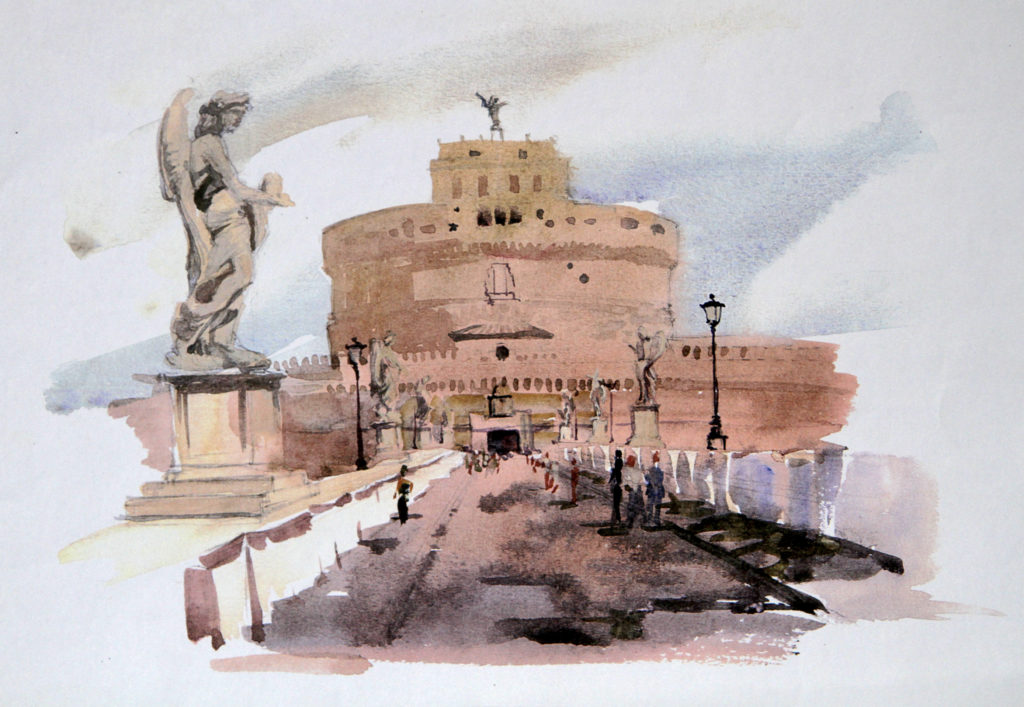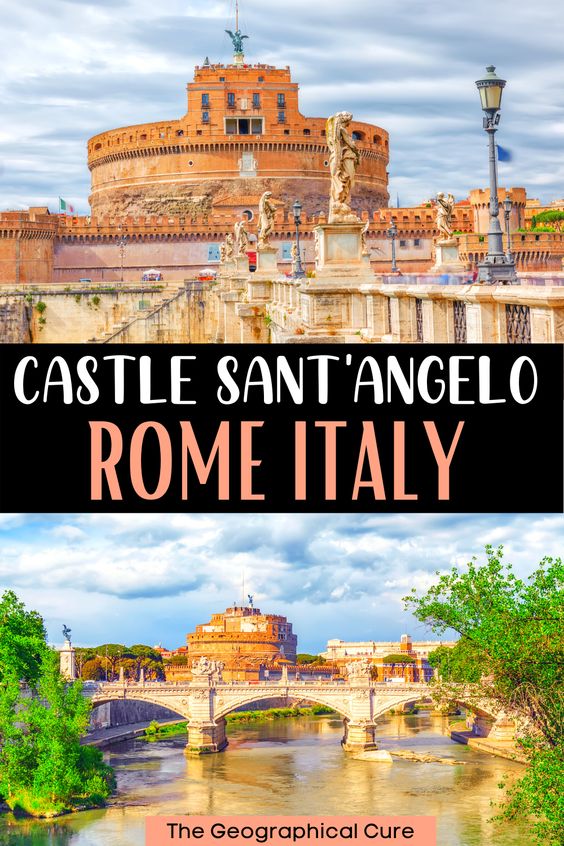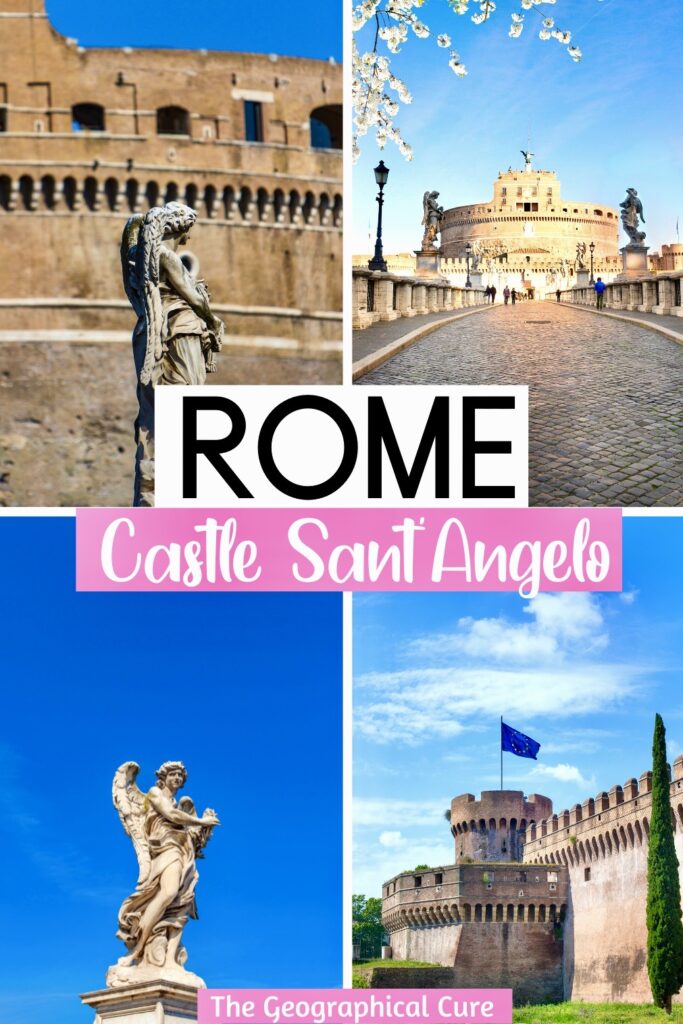Here’s my guide to visiting the Castle Sant’Angelo. The castle is a 2,000 year old landmark in Rome Italy.
As a national museum, it’s official name is the Museo Nazionale di Castle Sant’Angelo. You might consider the distinctive round bulwark a sign that you’ve arrived at Vatican City.
The castle is a former tomb of Emperor Hadrian decorated in papal splendor. Everyone walks by this famous Roman landmark. But not many go inside. Castle Sant’Angelo is thus a fascinating hidden gem in Rome, in plain sight.
Castle Sant’Angelo is the perfect reflection of Rome’s history. Though Castle Sant’Angelo owes its name to a medieval legend, its history dates back to ancient Rome.
Visiting the Castle Sant’Angelo is a walk through the entire history of Rome in one go.
In high season, you’ll want to book a skip the line ticket for the museum. You can also book a skip the line guided tour.
You can also visit the castle as part of a Dan Brown Angels and Demons tour. The castle is also included in the Roma Pass.
History of the Castle Sant’Angelo
In 139, Emperor Hadrian commissioned the castle’s construction as a mausoleum. It houses the remains of Hadrian, his descendants, and all of the emperors from Hadrian to Septimius Severus. Hence, Castle Sant’Angelo is also referred to a Hadrian’s Mausoleum.
The castle intentionally recalls the Mauseoleum of the Emperor Augustus across the river, which in turn was based on ancient Etruscan tombs. Unlike Rome’s other famous archaeological sites, Castle Sant’Angelo never fell into ruins. Instead, it continued to thrive as it was repurposed.
Castle Sant’Angelo was transformed from a tomb, to an impregnable fortress, to a prison, to a magnificent Renaissance dwelling, to a museum. Pope Clement hid there from the looting troops of the French king, Charles VII.
The facade of the cylindrical castle was originally richly decorated. But none of the ancient decoration survives.
They were plundered by invading goths or reused in new buildings. Historians believe the castle was once faced with travertine, marble, pilasters, bronze, and sculptures.
Eventually, the mausoleum was converted into a miltary fortress, as Rome was attacked by the Visigoths and the Ostrogoths. It was renamed Castle Sant’Angelo in the 5th century. The name means castle of the holy angel.
Legend holds that the castle was the site of a miracle. Pope Gregory I saw a vision of the Archangel Michael..
He appeared above the castle and sheathed his sword. Magically, this put an end to the plague. And so a pagan building became a Christian one.
In the 14th century, Castle Sant’Angelo was turned into a papal residence. A one mile long covered corridor, Il Passetto, connected it to St. Peter’s Basilica. Popes fled to the castle during sieges.
In the 15th century, at the direction of the notorious Borgia pope, Alessandro VI, the castle became battle ready. He also installed more sumptuous papal apartments.
In 1536, a marble and bronze statue of Archangel Michael was perched on top of the castle.
From the Terrace of the Angel, there are gorgeous 360 views of Rome and St. Peter’s Basilica. The museum also has a charming bar/coffee shop with splendid views.
In 1901, the Castle Sant’Angelo was decommissioned and turned into a national museum.
Overview Of Castle Sant’Angelo
There’s honestly a lot to see inside, spooky passageways and sumptuous salons. You’ll get a stair stepping workout. From the entrance, a winding spiral subterranean ramp leads you up five floors.
The museum is stuffed with centuries of goodies most suitable for history buffs. It’s an eclectic collection, including paintings, sculpture, military memorabilia, popes’ apartments, and a wonderful viewing terrace.
To me, the frescoed ceilings and panoramic view from the top were the museum’s best features.
Here’s the general layout of Castle Sant’Angelo:
- 1st floor: mausoleum and access ramp
- 2nd floor: former prison
- 3rd floor: military exhibits, Courtyard of the Angel
- 4th floor: papal apartments
- 5th floor: viewing terrace
Guide To Castle Sant’Angelo: What To See
Here are the things you need to see at Castle Sant’Angelo.
1. Papal Apartments
On level 4, you’ll find the papal apartments. This was where the popes hid out in times of danger.
There’s nothing of note art wise, except for perhaps Luca Signorelli’s Madonna and Child. Signorelli was a note painter during the Renaissance, with his master work at Orvieto Cathedral.
But the ceilings are stunning, with frescos by Perino del Vaga, Giulio Romano, and artists from Raphael’s workshop. Be sure to check out the Chamber of Cupid and Psyche, the Loggia of Julius II, the Loggia of Paul III (the most ornate), the Pauline Hall, the Perseus Room, and the Room of Apollo.
The Room of Apollo is the main room on first floor. It has a magnificent frescoed vaulted ceiling. The frescos consist of 10 panels telling stories of of Apollo.
2. Alexander VII Walkway
This is a circular corridor built in the 17th century by Pope Alexander VII, of the Chigi family.
It’s an open wall on the facade side, with a series of arches. From it, you have stunning views of Rome and the Vatican Museums.
There’s a cozy little restaurant/bar at the top, Caffetteria Ristorante Le Terrazze. You can sit down for an espresso and admire the splendid views. Just watch out for the pigeons.
3. Passage of Boniface IX
This passage is from the castle’s prison origins. You’ll see the reconstruction of a guard room, medieval weapons, and a trap door. Very Game of Thrones-ish.
The actual dungeons are only accessible via a private tour. Florentine artist Benvenuto Cellini, whose magnificent statue of Perseus adorns the Piazza della Signorina in Florence, was imprisoned there in the mid 1530s for looting papal funds.
Cellini attempted to escape by tying bed sheets into a rope. But he only succeeded in breaking his leg. His family finally bailed him out. He went on to produce great art and write one of the great autobiographies of the Renaissance era.
The Dominican Friar Giordano Bruno was also imprisoned in Cast Sant’Angelo’s dungeons. For his views on the state of the galaxy, he was then burned alive on the Campo dei Fiore, where you’ll now find his brooding statue.
4. Library
The library is one of two rooms built by Pope Paul III in the 1540s. The room provided access to the papal archives, which is why it was renamed the library in the 18th century.
The vault’s ceiling frescos decorated in a grotesque style, which became fashionable after the discovery of Nero’s Golden House during the Renaissance. They depict stories from ancient Rome with emblems of the Farnese family.
The artist, Luzio Luzzi, was inspired by famed Renaissance artist Raphael.
The library includes two adjoining nicely decorated rooms, the Sala della Adrianeo and the Sala dei Festoni.
5. Room of Urns
This is where the remains of Hadrian and his family were laid to rest.
6. Courtyard of the Angel | Courtyard of Honor
Dating from the 15th century, the Courtyard of the Angel gives you access to the papal apartments. There’s a statue of the Archangel, which originally was on top of the castle. It was sculpted by Michelangelo apprentice, Raffaelo da Montelupo.
You’ll also find the Shrine of Pope Leo X, designed by Michelangelo himself.
7. Terrazzo dell’Angelo | The Angel Terrace
The fifth floor of the Castle Sant’Angelo is its best feature. There’s a beautiful viewing terrace, which boasts perhaps Rome’s finest view.
Looking out over Rome, you can see modern buildings, Renaissance buildings, and Baroque buildings. You can even see the dome of the Pantheon, also built by Hadrian.
The tip top is crowned by a bronze statue of the Archangel Michael. The terrace is famous for starring in the last act of Puccini’s opera Tosca. The titular heroine throws herself off the roof after her lover is executed.
8. Other Areas
Castle Sant’Angelo also has other areas that are only accessible by a guided tour, which I didn’t do.
Those areas include the prison dungeons, the apartments of Pope Clement VII, and Il Passetto di Borgo (the popes’ escape corridor from the Vatican). The passetto was made famous by Dan Brown’s move, Angels & Demons.
This special tour has English tours at 10:00 am and 4:00 pm.
9. The Bridge of Angels | Ponte Sant’Angelo
Hadrian built the 1200 year old bridge leading to Castle Sant’Angelo for quick, easy, and regal access from central Rome to his tomb.
It was originally called the Bridge of Hadrian. But it’s name was changed in 1669, when the 10 Bernini-designed angels were added.
The three middle arches are Roman originals. The ancient Romans were some of the best engineers in history.
The angels each carry a symbol of Christ’s passion. The angels on the bridges are copies. But, if you’re on the Bernini trail in Rome, you can see the two Bernini originals in the Sant’Andrea della Fratte Church — the angel holding the crown of thorns and the angel holding the cartouche.
The bridge is a bit of a tourist trap these days. Avoid the pushy scammers and walk on.
Practical Guide & Tips For Castle Sant’Angelo
Address: Lungotevere Castello 50
Hours: Open daily 9:00 am to 7:30 pm. There may be extended hours during summer. Check the website.
Entry fee: 16 euros. There’s free entrance on the first Sunday of the month. The Roma Pass is also accepted.
Pro tip: You can download a free app for Castle Sant’Angelo for your visit, with free wifi onsite. There’s also plenty of signage.

I hope you’re enjoyed my guide to Castle Sant’Angelo. You may enjoy these other Rome travel guides and resources:
- 3 day itinerary for Rome
- 5 day itinerary for Rome
- Hidden gems in Rome
- Best museums in Rome
- Archaeological Sites in Rome
- Guide to the Borghese Gallery
- Rome’s secret palace museums
- Guide to free art in Rome
- Guide to Palatine Hill
- Guide to the Roman Forum
- Guide to the Colosseum
If you’d like to visit the Castle Sant’Angelo in Rome, pin it for later.


